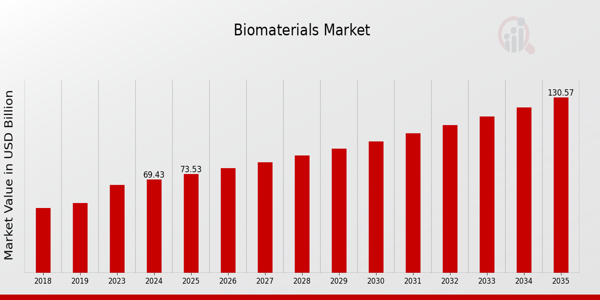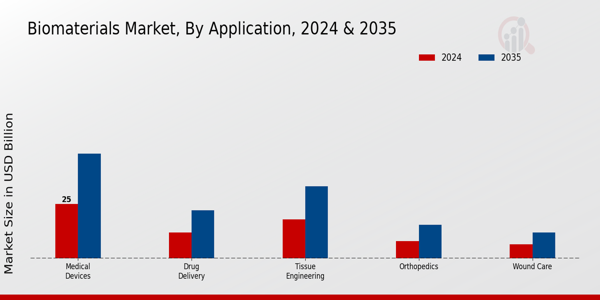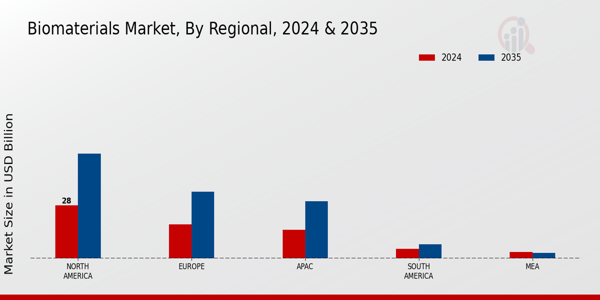Biomaterials Market Overview
As per MRFR analysis, the Biomaterials Market Size was estimated at 65.55 (USD Billion) in 2023. The Biomaterials Market is expected to grow from 69.43 (USD Billion) in 2024 to 130.5 (USD Billion) by 2035. The Biomaterials Market CAGR (growth rate) is expected to be around 5.91% during the forecast period (2025-2035).
Key Biomaterials Market Trends Highlighted
The growing need for biocompatible materials in medical applications is one of the major factors propelling the global biomaterials industry's notable expansion. The development of different biomaterials has been fueled by the growing demand for materials that may safely interact with biological systems as healthcare technology progresses.
The need for cutting-edge implants and medical equipment is increased by the world's aging population, which gives producers the chance to increase the range of products they offer. Additionally, the prevalence of chronic illnesses has increased the demand for efficient treatment strategies, which is driving more research and development in the biomaterials industry.
There are also more opportunities in the global biomaterials market, especially as governments keep funding research projects and healthcare facilities. This investment opens the door for industry participants and academic institutions to work together, which will result in advances in biomaterials technology.
For example, the use of biomaterials in regenerative medicine offers market players a great chance to investigate cutting-edge uses that might revolutionize patient care. Natural biomaterials are becoming more and more popular than synthetic ones, according to recent trends, because they are more environmentally friendly and better fit the human body.
Additionally, advances in 3D printing technology have simplified the process of creating personalized biomaterials, increasing therapeutic efficacy and improving patient outcomes. Additionally, in an effort to expedite the clearance process for new biomaterial products, regulatory authorities worldwide are updating their standards, which should support market expansion.
All things considered, the global biomaterials industry is poised for significant growth propelled by favorable market conditions and technical breakthroughs.

Source: Primary Research, Secondary Research, MRFR Database and Analyst Review
Biomaterials Market Drivers
Rising Demand for Biodegradable Products
The growing consumer awareness regarding environmental sustainability is driving the demand for biodegradable products globally. A report from the United Nations indicates that the global plastic waste is projected to reach 12 billion tons annually by 2030, necessitating a shift towards eco-friendly alternatives.
Established organizations like the World Wildlife Fund (WWF) and the Environmental Protection Agency (EPA) are advocating for reduced plastic usage, influencing the Biomaterials market to focus on sustainable solutions.
The Global Biomaterials Market is expected to see a significant uptick as manufacturers increasingly adopt bio-based materials to align with eco-conscious consumer demands and regulatory standards.
Technological Advancements in Material Science
Innovations in material science are significantly impacting the Global Biomaterials Market. The development of advanced materials that can mimic natural tissues is facilitating new applications in medical fields, particularly in regenerative medicine.
Research and Development initiatives have led to breakthroughs in 3D bioprinting technologies, which are being promoted by organizations like the National Institutes of Health (NIH). The reporting from NIH suggests that investments in bioprinting projects saw a 45% increase in funding over the past five years.
This surge is set to enhance the functionality and efficiency of biomaterials used in a wide array of medical applications, driving growth in the market.
Increasing Prevalence of Chronic Diseases
The rising prevalence of chronic diseases such as diabetes, cardiovascular diseases, and orthopedic disorders is a significant factor driving the Global Biomaterials Market. Reports suggest that approximately 422 million people globally were diagnosed with diabetes in 2014, a statistic that doubled over the past 30 years, according to the World Health Organization (WHO).
This surge in chronic conditions has led to an increased need for biomaterials used in implants, prosthetics, and surgical interventions. Medical organizations are thus aggressively pursuing advancements in biomaterials, indicating a strong growth potential in the industry.
Expanding Applications in the Healthcare Sector
The healthcare sector is increasingly adopting biomaterials in various applications, contributing significantly to the growth of the Global Biomaterials Market. According to the Food and Drug Administration (FDA), there has been a consistent year-on-year increase of 25% in the approval of new biomaterial-based medical devices.
This trend illustrates the rising confidence in biomaterials for safety and efficacy among regulatory bodies. The biomaterials used for drug delivery systems and tissue engineering are becoming vital to improving patient outcomes, further driving the demand in the healthcare market.
Biomaterials Market Segment Insights
Biomaterials Market Application Insights
The Global Biomaterials Market emphasized its application segment, showcasing diverse utilities across sectors such as Medical Devices, Tissue Engineering, Drug Delivery, Orthopedics, and Wound Care.
Within this segment, Medical Devices stood out significantly with a sterling valuation of 25.0 USD Billion, expected to rise to 48.0 USD Billion by 2035. This particular sub-segment highlighted how biomaterials played a pivotal role in enhancing the functionality and safety of various medical instruments and devices, thus commanding a substantial share of the market.
Tissue Engineering, valued at 18.0 USD Billion in 2024 and projected to reach 33.0 USD Billion in 2035, also underscored the transformative potential of biomaterials in regenerating or replacing biological tissues, making it immensely valuable in modern healthcare.
Additionally, the Drug Delivery segment, featuring a valuation of 12.0 USD Billion in 2024 and advancing to 22.0 USD Billion by 2035, emphasized the importance of biomaterials in enhancing the efficacy and bioavailability of medications, thus addressing critical therapeutic requirements.
The Orthopedics sub-segment, with valuations starting at 8.0 USD Billion in 2024 and escalating to 15.5 USD Billion by 2035, played a crucial role as biomaterials are integral in the design of implants and prosthetics, ensuring patient safety and comfort.
Furthermore, the Wound Care segment, beginning at 6.43 USD Billion in 2024 and expected to grow to 12.0 USD Billion by 2035, reflected the growing reliance on biomaterials for advanced dressings and surgical applications, showcasing their enhanced healing properties.
As the Global Biomaterials Market evolves, these sub-segments demonstrated critical advancements and provided valuable solutions in various medical fields, thus fostering overall market growth and expansion. The comprehensive market landscape showed the segmentation's robust structure and set the foundation for further exploration and investment opportunities in the Global Biomaterials Market.

Source: Primary Research, Secondary Research, MRFR Database and Analyst Review
Biomaterials Market Type Insights
The market can be categorized into several types, including Natural Biomaterials, Synthetic Biomaterials, and Modified Biomaterials. Natural Biomaterials are predominant in various applications due to their biocompatibility and minimal side effects, making them essential in medical implants and drug delivery systems.
Synthetic Biomaterials are gaining traction as they offer customizable properties for specific applications, thus creating opportunities in the fields of tissue engineering and regenerative medicine. Modified Biomaterials present unique benefits by enhancing existing natural or synthetic materials, leading to improved performance in medical devices.
The demand for these types of biomaterials is primarily driven by advancements in healthcare technology and increased investment in Research and Development. Market trends showcase a growing interest in sustainable and eco-friendly materials that align with global environmental regulations and consumer preferences.
As the Global Biomaterials Market continues to evolve, these types play a significant role in shaping industry standards and fostering innovation.
Biomaterials Market Source Insights
The Global Biomaterials Market is experiencing significant growth driven by diverse sources such as plant-based, animal-based, and microbial-based biomaterials. The increasing demand for eco-friendly and sustainable materials is propelling the popularity of plant-based biomaterials, which offer renewability and biodegradability.
Similarly, animal-based biomaterials continue to play a vital role in healthcare applications, particularly in tissue engineering and prosthetics, owing to their biocompatibility. Meanwhile, microbial-based sources are gaining traction for their potential to produce innovative materials through fermentation processes.
Together, these sources significantly contribute to the Global Biomaterials Market by catering to the healthcare, packaging, and automotive industries. Market growth is further supported by advancements in technology and Research and Development initiatives aimed at enhancing the performance of these biomaterials.
However, challenges such as regulatory hurdles and sourcing issues could impede progress. The Global Biomaterials Market is expected to benefit from opportunities in expanding applications across various industries, highlighting the essential role of these sources in shaping a sustainable future.
Biomaterials Market End-Use Insights
The segment encompasses various applications, notably in Healthcare, Pharmaceuticals, and Cosmetics. The Healthcare sector is a major driver, utilizing biomaterials for implants, prosthetics, and drug delivery systems, where biocompatibility is critical for patient safety and effectiveness.
Pharmaceuticals leverage biomaterials for drug formulations and delivery mechanisms, enhancing the therapeutic efficiency of medications. The Cosmetics industry increasingly incorporates biomaterials to improve product safety and efficacy, meeting consumer demand for natural and sustainable options.
Each of these segments contributes to the overall industry, with evolving trends emphasizing innovation, sustainability, and regulatory compliance. The continuous focus on Research and Development in these areas presents significant opportunities, while challenges such as the high cost of biomaterials and stringent regulations persist.
Overall, the Global Biomaterials Market segmentation reflects diverse applications that not only cater to key industries but also facilitate advancements in technology and health solutions globally.
Biomaterials Market Regional Insights
North America led the market with a substantial valuation of 28.0 USD Billion in 2024, anticipated to reach 55.0 USD Billion by 2035, thanks to advancements in Research and Development and increasing demand for biocompatible materials in medical applications.
Following closely, Europe, valued at 18.0 USD Billion in 2024, is expected to grow to 35.0 USD Billion by 2035, driven by stringent regulations favoring sustainable materials. The Asia-Pacific (APAC) region, valued at 15.0 USD Billion in 2024, experienced promising growth trends due to rising healthcare expenditures and a growing medical device market, expecting to reach 30.0 USD Billion by 2035.
South America, while smaller, showed potential with a valuation of 5.0 USD Billion in 2024, moving towards 7.5 USD Billion by 2035, largely due to enhancing healthcare infrastructure. The Middle East and Africa (MEA) market, valued at 3.43 USD Billion in 2024, is projected to stabilize at 3.0 USD Billion by 2035, facing challenges such as limited access to advanced technologies.
These regional dynamics highlighted a competitive landscape and varying opportunities in the Global Biomaterials Market, driven by regional needs and market conditions.

Source: Primary Research, Secondary Research, MRFR Database and Analyst Review
Biomaterials Market Key Players and Competitive Insights
The Global Biomaterials Market is characterized by a dynamic landscape where innovation, sustainability, and competitiveness drive the growth of various applications such as healthcare, tissue engineering, and environmental sustainability.
Competitive insights reveal that key players are leveraging advancements in technology and research to enhance product offerings, increase market penetration, and improve the overall efficiency of biomaterials.
As the demand for biocompatible, sustainable, and biodegradable materials grows, companies are focusing on differentiation through the development of innovative solutions tailored to meet the specific needs of diverse industries.
Competitive strategies often include strategic partnerships, collaborations, and investment in research and development, which play a crucial role in maintaining a competitive edge and addressing evolving market trends and consumer preferences.
DuPont holds a prominent position in the Global Biomaterials Market, known for its strength in research and innovation. With a commitment to developing sustainable solutions, DuPont focuses on creating high-performance biomaterials that cater to a wide range of applications, including medical devices and packaging.
The company capitalizes on its extensive technological capabilities and deep understanding of material science, which enables it to produce biomaterials that meet stringent regulatory requirements while also addressing the increasing demand for environmentally friendly products.
DuPont's market presence is supported by its well-established distribution networks and strategic partnerships, enabling the company to effectively reach international markets and reinforce its leadership in the biomaterials sector.
NatureWorks is a key player in the Global Biomaterials Market, recognized for its pioneering work in developing Ingeo, a leading biopolymer derived from renewable resources. The company emphasizes sustainability throughout its supply chain, focusing on producing biodegradable and compostable materials that align with global environmental goals.
NatureWorks has established a strong market presence due to its commitment to innovation, consistently introducing advanced products that cater to various industries, including packaging, textiles, and agriculture. The company's investment in research and development, coupled with its strategic collaborations and partnerships, enhances its market competitiveness.
NatureWorks has also engaged in mergers and acquisitions that bolster its capabilities and expand its global outreach, enabling it to reinforce its position as a leader in providing sustainable biomaterial solutions in the rapidly evolving market landscape.
Key Companies in the Biomaterials Market Include
- DuPont
- NatureWorks
- Merck KGaA
- Johnson and Johnson
- Corbion
- Zymergen
- Mitsubishi Gas Chemical Company
- Kraton
- Medtronic
- BASF
- CHT Group
- Tredegar Corporation
- Evonik Industries
- 3M
- Tokyo Chemical Industry
Biomaterials Market Developments
Recent developments in the Global Biomaterials Market have seen notable advancements in sustainability and innovation among leading companies such as DuPont, NatureWorks, and Merck KGaA. The demand for biopolymers continues to rise, driven by growing environmental awareness and regulatory pressures.
In September 2023, Johnson and Johnson announced a commitment to expand its biomaterials offering through strategic collaborations, reinforcing its position in the sector. Additionally, in August 2023, Corbion collaborated with Zymergen to enhance biobased product development, reflecting a trend towards integrating biotechnology into biomaterials.
Significant mergers have also occurred; in June 2023, Mitsubishi Gas Chemical Company acquired a majority stake in a key bioplastics firm, signifying its intent to bolster its biomaterials segment. Furthermore, research indicates that the Global Biomaterials Market is poised for growth, with a projected valuation increase driven by technological enhancements from companies like BASF and Evonik Industries.
The market's evolution is underpinned by regulatory support aimed at promoting sustainable materials, showcasing a shift towards bio-based alternatives that reduce reliance on fossil fuels. The last couple of years have also highlighted increased investment in biomaterials R&D, especially in the healthcare sector, evidenced by Medtronic’s focus on innovative solutions.
Biomaterials Market Segmentation Insights
-
Biomaterials Market Application Outlook
- Medical Devices
- Tissue Engineering
- Drug Delivery
- Orthopedics
- Wound Care
-
Biomaterials Market Type Outlook
- Natural Biomaterials
- Synthetic Biomaterials
- Modified Biomaterials
-
Biomaterials Market Source Outlook
- Plant-based
- Animal-based
- Microbial-based
-
Biomaterials Market End-Use Outlook
- Healthcare
- Pharmaceuticals
- Cosmetics
|
Report Attribute/Metric
|
Details
|
|
Market Size 2023
|
65.55(USD Billion)
|
|
Market Size 2024
|
69.43(USD Billion)
|
|
Market Size 2035
|
130.5(USD Billion)
|
|
Compound Annual Growth Rate (CAGR)
|
5.91% (2025 - 2035)
|
|
Report Coverage
|
Revenue Forecast, Competitive Landscape, Growth Factors, and Trends
|
|
Base Year
|
2024
|
|
Market Forecast Period
|
2025 - 2035
|
|
Historical Data
|
2019 - 2024
|
|
Market Forecast Units
|
USD Billion
|
|
Key Companies Profiled
|
DuPont, NatureWorks, Merck KGaA, Johnson and Johnson, Corbion, Zymergen, Mitsubishi Gas Chemical Company, Kraton, Medtronic, BASF, CHT Group, Tredegar Corporation, Evonik Industries, 3M, Tokyo Chemical Industry
|
|
Segments Covered
|
Application, Type, Source, End Use, Regional
|
|
Key Market Opportunities
|
Sustainable product development, Expanding medical applications, Innovations in drug delivery, Rising demand for biocompatibility, Government incentives for research
|
|
Key Market Dynamics
|
Increasing healthcare expenditure, rising demand for sustainable materials, advancements in material science, regulatory support for biocompatibility, and growing applications in tissue engineering.
|
|
Countries Covered
|
North America, Europe, APAC, South America, MEA
|
Frequently Asked Questions (FAQ) :
The Global Biomaterials Market was valued at 69.43 USD Billion in 2024.
By 2035, the Global Biomaterials Market is projected to reach a value of 130.5 USD Billion
The expected CAGR for the Global Biomaterials Market from 2025 to 2035 is 5.91%.
North America held the largest market share, valued at 28.0 USD Billion in 2024.
The North American Biomaterials Market is expected to be valued at 55.0 USD Billion by 2035.
The Biomaterials Market for Medical Devices was valued at 25.0 USD Billion in 2024.
The projected market size for Tissue Engineering is expected to be 33.0 USD Billion by 2035.
Key players in the Global Biomaterials Market include DuPont, NatureWorks, Merck KGaA, and Johnson Johnson.
The market size for Drug Delivery in 2024 was 12.0 USD Billion
The forecasted market size for Wound Care is estimated to reach 12.0 USD Billion by 2035.

















